 Image Credits - Iron fx
Image Credits - Iron fx
The Japanese government has announced a downward revision of its GDP growth forecast for fiscal year 2024, adjusting expectations from 1.3% to 0.9%. This recalibration reflects growing concerns over global economic uncertainties, domestic challenges, and a general slowdown in demand that have collectively impacted the nation’s financial outlook.
The revised forecast underscores policymakers’ cautious approach as they navigate a complex economic landscape. Global factors, including geopolitical tensions, fluctuating commodity prices, and trade disruptions, have contributed to a less favourable environment for economic growth. Specifically, the slowdown in major economies such as the United States and China, Japan’s key trading partners, has reduced export demand, adversely affecting Japan’s manufacturing and export sectors.
Domestically, Japan faces its own set of structural issues. The ageing population and shrinking workforce continue to pose long-term challenges to economic vitality. Despite various government initiatives to boost productivity and encourage greater participation in the labour force, demographic trends exert downward pressure on growth. Additionally, the pace of technological adoption and innovation, while robust in some sectors, needs to accelerate to counterbalance these demographic headwinds.
Consumer spending, a crucial component of Japan’s GDP, remains tepid. While employment rates are relatively stable, wage growth has been insufficient to significantly boost household spending. The lingering effects of the COVID-19 pandemic have also played a role in dampening consumer confidence and spending patterns. Despite the easing of pandemic-related restrictions, many consumers remain cautious, prioritizing savings over expenditure in the face of economic uncertainty.
The government has acknowledged these challenges and is poised to implement measures aimed at stimulating economic activity. These include increased public investment in infrastructure projects, incentives for technological innovation, and policies to attract foreign investment. Additionally, efforts to improve the business environment and support small and medium-sized enterprises (SMEs) are expected to play a critical role in fostering economic resilience.
Monetary policy continues to be a pivotal tool in the government’s strategy to bolster growth. The Bank of Japan (BOJ) has maintained its ultra-loose monetary policy stance, aiming to keep interest rates low and support lending and investment. However, the effectiveness of monetary policy alone is limited, necessitating a coordinated approach with fiscal measures and structural reforms.
Despite the lowered growth outlook, there are areas of optimism. Japan’s efforts to enhance its digital economy, focus on sustainable energy, and strengthen regional trade partnerships offer pathways for future growth. The upcoming Expo 2025 in Osaka and other international events could also serve as catalysts for economic activity and tourism, providing a potential boost to the economy.
